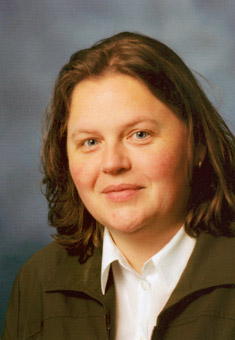 Sabine Beuermann studied chemistry and received a Ph.D. in Physical Chemistry in the group of Michael Buback at the Georg-August-University of Göttingen. After working as a visiting scientist at the DuPont Experimental Station in Wilmington/DE, she returned to Göttingen to work on her habilitation, which was finalized with the habilitation thesis on homogeneous phase polymerizations in supercritical carbon dioxide and the venia legendi for Technical and Macromolecular Chemistry. Since 2006 she is professor of Polymer Chemistry at the University of Potsdam. Current research interest include synthesis, characterization, and modification of vinylidene fluoride polymers, polymerizations in supercritical carbon dioxide or ionic liquids, reversible deactivated radical polymerizations, functionalization of nanoparticles or fullerenes with fluorinated polymers, and detailed investigations into the kinetics of radical polymerizations. Since 1996 she is a member of the IUPAC Subcommittee on “Modeling of Kinetics and Processes of Polymerization”.
Sabine Beuermann studied chemistry and received a Ph.D. in Physical Chemistry in the group of Michael Buback at the Georg-August-University of Göttingen. After working as a visiting scientist at the DuPont Experimental Station in Wilmington/DE, she returned to Göttingen to work on her habilitation, which was finalized with the habilitation thesis on homogeneous phase polymerizations in supercritical carbon dioxide and the venia legendi for Technical and Macromolecular Chemistry. Since 2006 she is professor of Polymer Chemistry at the University of Potsdam. Current research interest include synthesis, characterization, and modification of vinylidene fluoride polymers, polymerizations in supercritical carbon dioxide or ionic liquids, reversible deactivated radical polymerizations, functionalization of nanoparticles or fullerenes with fluorinated polymers, and detailed investigations into the kinetics of radical polymerizations. Since 1996 she is a member of the IUPAC Subcommittee on “Modeling of Kinetics and Processes of Polymerization”.
Please follow the link for further information on Sabine’s laboratory and her recent paper in Polymer Chemistry.
What was the motivation behind the research in your recent Polymer Chemistry paper? (DOI: 10.1039/C1PY00427A)
Initially, we started to look into vinylidene fluoride polymerizations, because I was interested in the kinetics and to use supercritical carbon dioxide as an environmentally friendly reaction medium. Since the very first PhD student working on this topic, M. Imran-ul-haq, had a background in organic chemistry he also started with the functionalization to an azide. Because of its ferro-, piezo, and pyroelectric properties there are many advanced applications for PVDF. Of particular interest are systems with separated PVDF domains, e.g. voids in PVDF or layer formation due to self-aggregation. From this point it was pretty obvious to think about the synthesis of block copolymers with PVDF. However, with the exception of iodine transfer polymerizations vinylidene fluoride is not well suited for reversible deactivated radical polymerization and thus, there were almost no reports on PVDF block copolymers. Obviously, using polystyrene as a second block was only the starting block. We are now working on block copolymers with a number of other polymers.
Why did you choose Polymer Chemistry to publish your work?
Although being a young journal Polymer Chemistry is already well-recognized and the fraction of articles I am interested in is comparably large. Moreover, I like the design of the articles, and the “clean” structure of the homepage. After publication of the article I can also add that the whole process was very fast and went very smoothly.
In which upcoming conferences may our readers meet you?
I am most excited on attending the 20th International Symposium on Fluorine Chemistry in Kobe in July, because it will be my first trip to Japan. In addition, I will go to the Freiburger Makromolekulares Kolloquium in February, the Polymer Reaction Engineering conference in May and probably to MACRO2012 in June.
How do you spend your spare times?
In my spare time I try to make as little plans in advance as possible. I enjoy walking in the beautiful parks and surroundings of Potsdam, trips to the North or Baltic Sea and visiting family.
Which profession would you choose if you were not a scientist?
Maybe a historian, but I am very happy with the choice I made.










